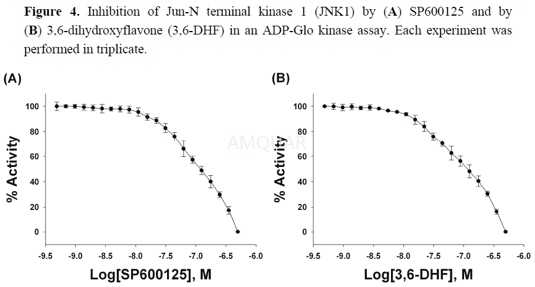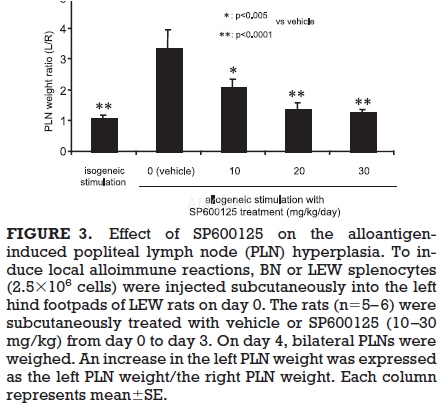-
生物活性
SP600125 is a chemical compound that is a derivative of anthrone. It is used in biochemical studies as an inhbitor of c-Jun N-terminal kinases (JNKs).Derivatives of SP600125 have a variety of biological activities. SP600125 is a potent, selective and reversible inhibitor of the three JNK enzymes (c-Jun N-terminal kinases), with IC50 = 40 nM for JNK1 and JNK2, and 90 nM for JNK3. Inhibition is competitive with respect to ATP, and over 300-fold more selective for JNK as compared to ERK1 and p38-2 MAP kinases. SP600125 was shown to cause a dose-dependent inhibition of the phosphorylation of c-Jun, and thereby the expression of inflammatory genes COX-2, IFN-γ, IL-2, TNF-α, and block the activation and differentiation of primary human CD4 cell cultures. SP 600125 has also been shown to prevent apoptosis in an array of cell types, and inhibit autophagy in HeLa cells.Active in vivo. Exhibits reduced selectivity over other protein kinases under certain conditions. Protects renal tubular epithelial cells against ischemia/reperfusion-induced apoptosis. Prevents BMP9-induced osteogenic differentiation of MSCs. Essential component of medium for maintaining stem cells in naive pluripotent state.
SP600125inhibited phosphorylation of c-Jun,[1] LPS-induced iNOS protein expression and NO production,[1] LPS-induced COX-2 protein levels and PGE2 production[2] with an IC50 of 5 to 10μM. SP600125suppressed mixed lymphocyte reaction and OX52-positive lymphocyte proliferationwith an IC50 of 1.5 to 5.7μM.[3]
SP600125 Suppressed AhR transformation and DNA bindingwith an IC50 of~ 7μM andIC50 forhuman breast epithelial cell line MCF10A is ~2μM.[4]
Kinase activity of SP600125[5][6]

Another study shows that the IC50 of SP600125 for Mps1 is 98 nM.[7]
-
体外研究
-
体内研究
30% PEG400+0.5% Tween80+5% Propylene glycol
-
激酶实验
Reagents[8]
Testing compounds were dissolved in H2O: DMSO (9:1, v/v) at 10 mg/mL in order to prepare the stock solution.
Measurement of Protein Kinase Activity Using ADP-Glo Kinase Assay
ADP generation was measured with protein kinase assays using the luminescent GDP-Glo assay kit from Promega. The increase of the luminescence signal indicates the generation of ADP by the protein kinase reaction. We performed the protein kinase assays according to the following assay protocol: Serial 2-fold dilutions of 3,6-DHF and SP600125 as a JNK inhibitor in 1× kinase reaction buffer were prepared and mixed with 20 nM JNK1 and 10 μM ATP. This assay was initiated by incubating the reaction mixture in a 96-well white culture plate at 30 °C for 30 min. After the incubation period, ADP-Glo reagent was added to terminate the kinase reaction. The 96-well white culture plate was incubated for 40 min at room temperature. The kinase detection reagent was then added to convert ADP to ATP and introduce luciferase to detect ATP. The 96-well white reaction plate was incubated for 30 min and then the luminescence was read with a plate-reading luminometer.
-
细胞实验
Use of SP600125 in Cell Culture. [5]
SP600125 is poorly soluble in water. Stock solutions of at least 20 mM can be made by using 100% dimethyl sulfoxide. As a general guide, for every 10 μM SP600125, it is recommended to include
0.1% DMSO in the culture media (e.g., 30 μM0.3% DMSO). Prewarming of media and the use of serum protein may enhance solubility. SP600125 typically precipitates as fine needles that are visible at 50-fold magnification
Multiplex Analysis of mRNA.
Multiarray plate screening of mRNA was performed by High Throughput Genomics (HTG, Tucson,
AZ). In brief, cell lysates were prepared by using a single-step proprietary lysis buffer. Lysates were incubated with a 16-gene capture array manufactured into each well of a 96-well plate. Detection was by luminescence and was performed by HTG. SDs for triplicate samples were typically 3–8% for samples with high levels of gene expression and 15–25% for samples with very low (near-threshold) levels of cytokine gene expression.
-
动物实验
Reagents[3]
For in vivo treatment, SP600125 was prepared daily and dissolved in 30% polyethylene glycol 400, 20% propylene glycol, 15% Cremophor EL,5%ethanol, 30% saline (PPCES). To obtain a desired dose as indicated, 2.5 ml of the drug solution per kg body weight was administered subcutaneously to a rat.
Popliteal Lymph Node (PLN) Hyperplasia Bioassay
Splenocytes were isolated from LEW or BN rats. Ficoll density gradient centrifugation was applied to the single cell suspension to sediment erythrocytes and polynuclear leukocytes. Trypan blue exclusion indicated >90% cell viability, and the resultant viable mononuclear cells were resuspended in RPMI 1640 to a final working concentration of 1.25x108cells/ml. For allogeneic stimulation, 2.5x106BN splenic leukocytes (20μL) were injected subcutaneously into left hind footpads of LEW rats using a repeating syringe fitted with a 27-gauge hypodermic needle on day 0. LEW splenocytes were used for isogeneic control. The rats were untreated, or treated daily with SP600125 or vehicle for 4 days (day 0 to 3) at doses indicated. Each group contained at least five animals, and there was no difference among body weights of all experimental groups at the time when experiments were begun. On day 4, bilateral PLNs were removed and weighed. The enlargement of the left PLN relative to the unstimulated right PLN was expressed as weight ratio of the left to the right node.
-
不同实验动物依据体表面积的等效剂量转换表(数据来源于FDA指南)
|  动物 A (mg/kg) = 动物 B (mg/kg)×动物 B的Km系数/动物 A的Km系数 |
|
例如,已知某工具药用于小鼠的剂量为88 mg/kg , 则用于大鼠的剂量换算方法:将88 mg/kg 乘以小鼠的Km系数(3),再除以大鼠的Km系数(6),得到该药物用于大鼠的等效剂量44 mg/kg。
-
参考文献
[1] Lahti A JU, Kankaanranta H, Moilanen E. c-Jun NH2-terminal kinase inhibitor anthra(1,9-cd)pyrazol-6(2H)-one reduces inducible nitric-oxide synthase expression by destabilizing mRNA in activated macrophages. Mol Pharmacol. . 2003;64(2):308-315.
[2] Nieminen R, Lahti A, Jalonen U, Kankaanranta H, Moilanen E. JNK inhibitor SP600125 reduces COX-2 expression by attenuating mRNA in activated murine J774 macrophages. Int Immunopharmacol. 2006;6(6):987-996.
more
分子式
C14H8N2O |
分子量
220.23 |
CAS号
129-56-6 |
储存方式
﹣20 ℃冷藏长期储存。冰袋运输 |
溶剂(常温)
|
DMSO
100 mM |
Water
partly soluble |
Ethanol
5 mM |
体内溶解度
约21 mg/mL
-
Clinical Trial Information ( data from http://clinicaltrials.gov )
注:以上所有数据均来自公开文献,并不保证对所有实验均有效,数据仅供参考。
-
相关化合物库
-
使用AMQUAR产品发表文献后请联系我们





















